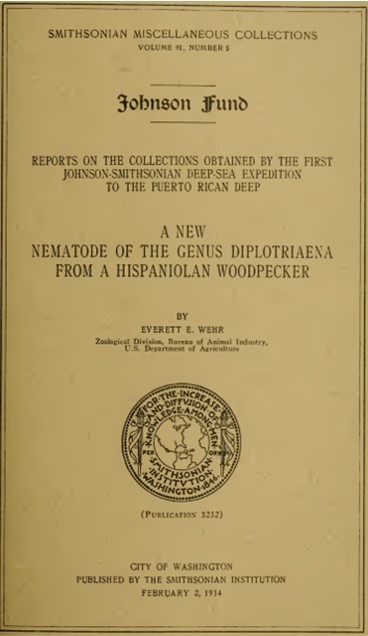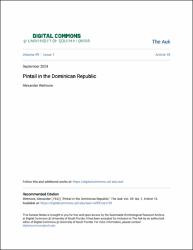Listar Investigación ambiental por Año
Mostrando ítems 21-40 de 1621
-
Mammals eaten by Indians, owls, and Spaniards in the coast region of the Dominican Republic (with two plates)
(1929)In February and March, 1928, I visited the Samana Bay region, northeastern Dominican Republic with the special object of obtaining remains of mammals in the Indian deposits that had been previously examined by Gabb in ... -
Archeological and historical investigations in Samaná, Dominican Republic
(1929)This is a comprehensive study exploring the archaeology and history of the Samaná region in the Dominican Republic. Presented as Bulletin 147 of the United States National Museum, it documents archaeological findings, ... -
Three small collections of mammals from Hispaniola (with two plates)
(1930)The United States National Museum has received from Haiti and the Dominican Republic three small collections of mammals that have not yet been reported on. The first was made in a sheltered side crevice, probably once the ... -
The birds of Haiti and the Dominican Republic
(1931)The book is an ornithological treatise on the avifauna of the island of Hispaniola (divided between the nations of Haiti and the Dominican Republic) in the Caribbean. It is based on the fieldwork carried out, and collections ... -
Wetmore's 'The Birds of Haiti and the Dominican Republic'
(1931)As is generally known, Dr. Alexander Wetmore has for some time been interested in the bird life of Haiti and San Domingo, and the results of his explorations in the island and his studies of its avifauna have just been ... -
The Hudsonian godwit in the Dominican Republic
(1931)The Hudsonian Godwit in the Dominican Republic.--Dr. R. Ciferri, Director of the Experiment Station at Santiago, D. R., has presented to the U.S. National Museum a specimen of the Hudsonian Godwit Limosa haemastica taken ... -
Notes from Dr. R. Ciferri on the Birds of Hispaniola
(1932)In connection with the recent publication of a list of the birds of Hispaniola, Dr. R. Ciferri of Santiago, Dominican Republic, has forwarded certain observations that it is desirable to have on permanent record. -
Additional notes on the birds of Haiti and the Dominican Republic
(1933)In continuation of biological studies in Hispaniola under the Smithsonian Institution, we were engaged in field investigations in Haiti and the Dominican Republic in the spring of 1931, being oc cupied principally with ... -
Records from the Dominican Republic
(1933)Mr. George Hamor of Barahona, Dominican Republic, in two recent letters has supplied additional information on the range of the introduced Black and Yellow Mantled Weaverbird (Textor cucullatus cucullatus) that is of ... -
A partial list of birds observed in Haiti and the Dominican Republic
(1934)The birds here listed are some of those noted on a limnological expedition to the island, lasting from February 5 to March 15, 1933. As will be observed, the greater part of the birds mentioned are aquatic, since they were ... -
A new nematode of the genus Diplotriaena from a Hispaniolan woodpecker
(1934)The species of nematode described in this paper was collected from the body cavity of a Hispaniolan woodpecker killed near Santa Barbara de Samaná, Dominican Republic, by E. W. Price. -
The herpetology of Hispaniola
(1941)This study of the herpetology has been undertaken for the purpose of advancing the survey of the amphibian and reptile fauna of the Greater Antilles. Of these islands Hispaniola has remained the least known faunistically ... -
Migrant ducks in the Dominican Republic
(1941)Mr. Hugh A. Johnston, resident for years near Monte Cristi in the northwestern part of the Dominican Republic, has written me recently that migratory ducks have come to his region in great abundance during the last two ... -
Pintail in the Dominican Republic
(1942)In our account of the birds of Haiti and the Dominican Republic (Bull. U.S. Nat. Mus., no. 155: 100, 1931), B. H. Swales and I recorded the Pintail (Dafila acura tzitzihoa) as of uncertain status. Mr. Hugh A. Johnston of ... -
Nidification of the passerine birds of Hispaniola
(1943)When I began my survey of the avifauna of the West Indies in 1927 very little was known of the nesting habits of the birds of Hispaniola, and I tried to fill this gap during the nine months that I spent on the island. It ... -
Riqueza forestal dominicana (tomo I) [tercera edición corregida y ampliada]
(1945)Primer volumen de una serie de tres obras que constituyen un manual científico-técnico con descripciones de las especies de la flora de la República Dominicana. -
A review of the forms of the Brown Pelican
(1945)When W. L. Abbott began sending birds from Hispaniola more than 25 years ago, Charles W. Richmond and I recognized that the Brown Pelicans of that island were smaller than those of the southeastern United States and therefore ... -
Origin of the bird fauna of the West Indies
(1948)Although our knowledge in ornithology of the West Indies (which include the Antilles, Cayman and Swan Islands, St. Andrew and Old Providence, and the Bahama Islands) far surpasses that in any other natural science, there ... -
Árboles de la flora dominicana
(1949)La obra constituye un manual sobre los nombres de las especies de árboles de la flora dominicana, incluyendo sus nombres vulgares y científicos, sinónimos dominicanos y sinónimos latinos.




















